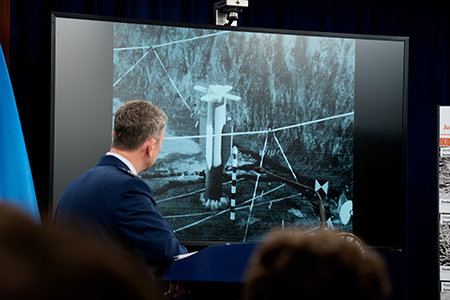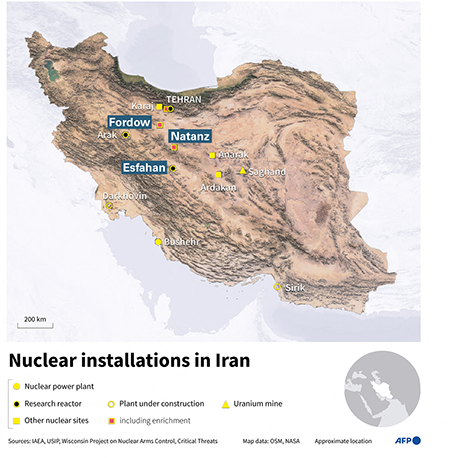Israel and U.S. Strike Iran’s Nuclear Program
July/August 2025
By Kelsey Davenport
U.S. President Donald Trump claimed that Israeli and U.S. strikes against Iranian nuclear facilities obliterated the program, but early intelligence assessments and the head of the International Atomic Energy Agency (IAEA) suggest that the program may only have been set back a matter of months.

Neither the United States nor Israel presented intelligence suggesting that Iran had decided to weaponize its nuclear program, but the strikes are prompting debate in Iran about the value of the nuclear Nonproliferation Treaty (NPT) and negotiations with the United States.
Trump announced that the United States conducted a “very successful attack” on three Iranian nuclear sites in a June 21 Truth Social post. For the first time, the United States used the largest bomb in its conventional arsenal, the massive ordinance penetrator, to target the deeply buried Fordow uranium enrichment facility. Tomahawk cruise missiles were deployed against the Natanz uranium enrichment facility and the Esfahan complex, where Iran conducted uranium conversion activities and stored at least some of its highly enriched uranium.
All three sites were part of Iran’s declared nuclear program and under IAEA safeguards. The agency’s director-general, Rafael Mariano Grossi, said in a June 17 CNN interview that the IAEA “did not have proof of a systemic effort [by Iran] to move into a nuclear weapon.” Grossi condemned the strikes and told the UN Security Council June 20 that “armed attacks on nuclear facilities should never take place.”
The U.S. strikes followed a week of Israeli strikes on Iran’s nuclear facilities that began June 13. Israel’s initial targets included Natanz and the assassination of more than a dozen top Iranian nuclear scientists. Israel also targeted key Iranian military leaders and ballistic missile launch sites. In the following days, Israel damaged several buildings at Esfahan and an unfinished reactor at the Arak site.
Israeli Prime Minister Benjamin Netanyahu did not present any intelligence suggesting that Iran’s nuclear program posed an imminent threat. He said June 13 that the strikes were intended to “eliminate” Iran’s nuclear and missile program.
Israel, however, does not have the military capabilities to target Iran’s deeply buried and hardened nuclear facilities. Netanyahu’s determination to “eliminate” the program, despite lacking the conventional capabilities to do so, suggests that he sought to pull the United States into the conflict to target the facilities beyond Israel’s reach.
Hours after the June 13 strikes, Iran responded with counterstrikes targeting Israel. Israel, with U.S. assistance, intercepted the majority of the incoming missiles and drones, but over the course of the 12-day conflict, some missiles did make it through Israel’s defenses.
Iran’s Supreme Leader, Ayatollah Ali Khamenei, claimed victory, saying in a June 24 address that Iran struck a “large number of [Israeli] military” targets and critical infrastructure. He downplayed the attacks on Iran’s nuclear facilities, saying the strikes could not achieve “anything significant.”
Iran and Israel accused each other of deliberately targeting civilian areas during the 12-day conflict.

Following the U.S. attack, Iran launched ballistic missiles at the U.S. Al-Udeid Air Base in Qatar. Trump said that Iran warned the United States ahead of the June 23 attack, mitigating the damage caused by the strike. The advance warning suggested that Iran sought to prevent further escalation with the United States.
Following the counterstrike, Trump announced a ceasefire and called for peace.
Although the U.S. and Israeli strikes damaged key Iranian nuclear facilities, it is unclear how much the military action set back Iran’s nuclear program.
Following the U.S. strikes on Fordow, Natanz, and Esfahan, the U.S. Defense Intelligence Agency assessed in a classified report that the strikes only set back Iran’s nuclear program by “maybe a few months,” an official familiar with the report told CNN. Unnamed officials quoted by CNN said that Iran’s stockpile of enriched uranium was not destroyed by the strikes and that Iran’s centrifuges are largely intact.
U.S. officials, including Trump, rejected the assessment. Trump insisted repeatedly, including in a June 29 interview on Fox News, that the strikes “obliterated” Iran’s nuclear program. U.S. Director of National Intelligence Tulsi Gabbard said Iran’s nuclear facilities were “destroyed” and it would take “years” for Iran to rebuild Natanz, Fordow, and Esfahan. In a June 25 statement, the Israel Atomic Energy Commission offered a similar assessment, saying that the combined strikes set back Iran’s ability to build nuclear weapons “by many years.” On July 2, the Pentagon put the estimate at “one to two years.”
Grossi, however, assessed that Iran could resume uranium enrichment in a “matter of months.” In a June 29 interview with CBS, he said that although Iran’s facilities were “severely damaged,” the country has the “industrial and technological capabilities” to rebuild.
Grossi also raised concerns about the whereabouts of Iran’s enriched uranium, which Tehran had threatened to move from its declared sites in the event of an attack. Following the Israeli strikes, Iran informed the IAEA that it would take “special measures” to protect its nuclear materials.
U.S. Vice President JD Vance admitted in a June 23 interview on Fox News that the United States does not know if the strikes destroyed Iran’s stockpile of uranium enriched to near-weapons-grade levels.
Iran was enriching uranium to near-weapons-grade levels before the Israeli strike. According to a May 31 IAEA report, Iran had produced more than 400 kilograms of uranium enriched to 60 percent uranium-235. That stockpile, if enriched to the 90 percent U-235 that is considered weapons-grade, would be enough for about 10 bombs.
Vance said the goal was to “bury” the material and ensure Iran cannot enrich it further. According to a CNN report, Gen. Dan Caine, chairman of the Joint Chiefs of Staff, told senators in a June 26 classified briefing that the United States does not have the military capability to destroy the deeply buried facilities at Esfahan, where Iran may have been storing that material. The U.S. Tomahawk strike on Esfahan may have been designed to collapse the entrances to the facility. Grossi said in a June 22 statement that the attack “impacted” the entrances to the underground tunnels at the site.
But Marco Rubio, the U.S. secretary of state and interim national security advisor, suggested that the whereabouts of Iran’s near-weapons-grade uranium is immaterial, given the destruction of Iran’s uranium metal production facility at Esfahan. Iran would need to convert uranium from gas to the metal form necessary to build a bomb. Iran “can’t do a nuclear weapon without a conversion facility,” Rubio told CBS News
on June 22.
Grossi called for the return of IAEA inspectors to Iran’s nuclear facilities and begin trying to account for nuclear materials, but Amir Iravani, Iran’s ambassador to the UN, said the agency “cannot have access” to Iran’s nuclear sites.
Esmaeil Baghaei, Iran’s foreign ministry spokesman, said in a June 16 press briefing that the parliament drafted legislation calling for the country to withdraw from the NPT. The parliament chose instead to pass a law June 18 prohibiting cooperation with the IAEA. Iran, as an NPT state-party, is legally required to implement a safeguards agreement with the IAEA. The new law, however, requires that before resuming cooperation with the agency, Iran must receive assurances that its nuclear facilities and scientists will be secured and that its NPT rights, including the right to enrichment, will be respected. The law entered into effect July 1.
The NPT guarantees that non-nuclear-weapon states can access nuclear technology for peaceful purposes under IAEA safeguards but does not explicitly mention a right to uranium enrichment.
Grossi said the implications of the Iranian law on the agency’s ability to conduct safeguards is unclear, but he emphasized the importance of the IAEA returning to Iran’s nuclear facilities and conducting inspections.
Araghchi said in a June 26 interview with Tasmin that Iran has “no plans” to invite Grossi to Tehran. Iranian President Massoud Pezeshkian told French President Emmanuel Macron in a June 30 call that Iran’s trust in the agency is broken, primarily because the agency did not condemn the United States and Israel for attacking Iranian sites.
Macron said in a June 23 press conference in Oslo that France shares the goal of preventing Iran from developing nuclear weapons but that “there is no legality” in the U.S. strikes on Iran.
In addition to the technical challenges posed by the prohibition on the IAEA, there are political challenges to resuming negotiations.
Israel struck Iran shortly before Iranian and U.S. negotiators were set to meet for a sixth round of talks on a new nuclear deal, leading some Iranian policymakers to accuse the United States of not negotiating in good faith.
In his June 26 interview, Araghchi said that the United States “betrayed diplomacy mid-negotiation” and the experience will influence Iran’s decision about future talks. He said the strikes make reaching an agreement “far more complex and complicated.”
Since the June 21 strikes, the Trump administration has sent mixed messages about its interest in returning to negotiations. After suggesting June 25 that talks would resume the following week, Trump said that the United States and Iran “may sign an agreement,” but he does not “think that it’s necessary.”
In a June 25 interview with CNBC Steve Witkoff, Trump’s envoy to the Middle East, suggested, however, that the United States will continue to push for a deal.
He said that “enrichment is the redline” and that Iran should pursue a nuclear program similar to that of the United Arab Emirates, which signed a nuclear cooperation agreement with the United States in which it voluntarily gave up uranium enrichment and plutonium reprocessing.
Iranian President Massoud Pezeshkian said in a July 7 interview with Tucker Carlson that a deal with the United States is possible, but that Iran's nuclear rights must be respected. He also questioned how Iran can trust Trump to negotiate in good faith after the military strikes. Trump has suggested that Iran would more likely accept U.S. terms for a deal after the military strikes.
